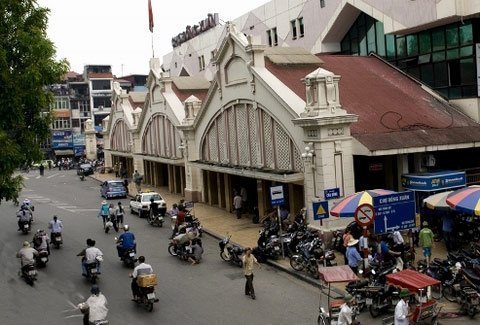VietNamNet Bridge – Upgrading the operational traditional markets into modern
ones is a must. However, it is necessary to find out a suitable model for the
new markets.
 |
|
The Dong Xuan Market in Hanoi |
Despite the failures, Hanoi authorities still insist on renovating the traditional market network, trying to turn them into modern markets, suitable to a modern capital city.
Hanoi’s initiative of setting up building blocks for all traditional markets, shopping malls and working offices in one has tasted the failure. The modern Cua Nam market in Hoan Kiem district is a typical example. It cannot attract housewives since the day it began operation.
Hanoi has also failed with the project on building Hang Da market, because it “tried to build a new market with old way of thinking.” Meanwhile, the Mo market is still being built the same way.
“New markets have been built under the mode of modern building blocks with thick wall, glass doors which are “as secret as a grave.” However, the markets have been left deserted and cold,” Nguyen Van Dung, an architect, commented.
While the heavily invested modern markets remain quiet with few visitors, the nearby sales points have always been crowded and bustling, from early in the morning to late in the evening.
“It’s a pity that to date, the unreasonable thoughts about the modern markets still exist,” Dung added.
Hanoi’s authorities vow to renovate the existing traditional markets, but they have not listened to the voice of the public. Meanwhile, in principle, the opinions of salesmen and customers need to be respected when the city’s localities consider the plans to upgrade the markets.
Which models for Hanoi’s traditional markets?
While the city’s leaders still discuss to find out suitable models for Hanoi’s markets, experts point out that the Dong Xuan Market in Hanoi, or Ben Thanh and An Dong Markets in HCM City are the success stories of renovating markets.
According to the management board of the Dong Xuan Market, while other modern markets like Hang Da and Cua Nam have been keeping consumers away, Dong Xuan has been developing in a sustainable way.
It is because, unlike the shopping malls and supermarkets, clean and shiny, with a lot goods, mostly high grade and expensive products, Dong Xuan is the market, where people can find everything they need, from low cost to high quality products.
“The key is that the goods prices here fit the pockets of the majority of people. Everyone can go to Dong Xuan market, from low income to high income earners. As such, Dong Xuan target a wider range of customers than modern markets,” a representative of Dong Xuan Market’s board of management said.
He went on to say that the investors should not only try to earn money, but also need to pay attention to the influences of the markets to the socio-economic life.
Deputy Director of the HCM City Department of Industry and Trade also said that though the city has modern shopping malls, supermarkets, convenience stores, it also has 243 traditional markets which have been playing a very important role in the life of the city’s residents.
The merchants at An Dong Market, one of the biggest traditional markets in HCM City, pays 60 billion dong to the city’s budget every year, a very satisfactory result in the context of economic recession.
As such, Hanoi absolutely can have modern markets while no need to eliminate traditional markets. However, in order to do that, it’s necessary to find out suitable models for the markets.
Source: VnMedia